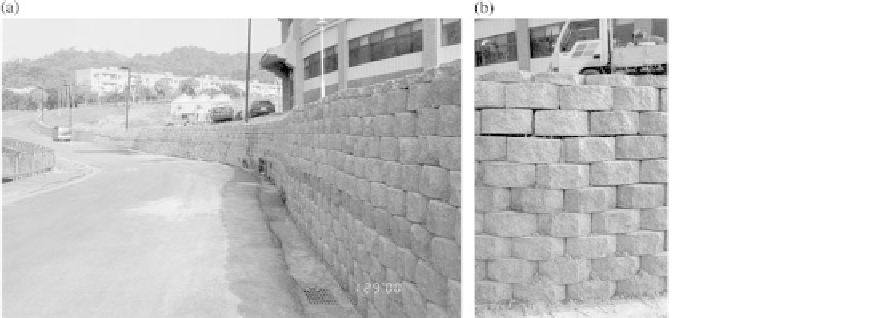Geoscience Reference
In-Depth Information
the transverse stiffness and strength of geogrid, as well as that of the pins, are
required to keep the modular blocks in place under large dynamic earth pressure
induced by the earthquake.
4.3 Chung-Hsin Stadium, Chung Hsin New Village
Modular block reinforced soil retaining walls were used extensively around
Chung-Hsin Stadium. Two walls were affected by the earthquake.
The first wall was located along the side of the stadium, of height 2m or
less (Fig. 8a). A series of lampposts was installed very close to the wall. It was
observed that the blocks dislocated around the location of the lampposts (Fig. 8b).
The connection pins were seen through the spacing between the blocks. The
deformations were due to the movement of the foundation of the lamppost. The
post deflected inward and thus pushed the foundation outward to the wall.
The problem could be avoided by installing the post at a distance away from the
wall, or with a deeper foundation.
The second wall was located behind the stadium, 3 m high
(Fig. 9a).
At the
crest of the wall, two cracks were observed. The first crack was about half a meter
from the block, whereas the second crack was more than 2m from the block. The
blocks moved away from the backfill for over 30 cm. This wall collapsed at the
lower corner. A close view of the bottom corner appears in Fig. 9b. Note that
the length of reinforcement at the corner is likely less than normal because of the
limited space available behind the wall. The reinforcement used was a polyester
geogrid, with a vertical spacing of 3 blocks. Thus, the top layer had a spacing
Figure 8
Chung Hsin Stadium: (a) geosynthetic reinforced soil retaining wall along the
side of the stadium; (b) the gap exposing the connection pins at the location of lamppost.









Search WWH ::

Custom Search